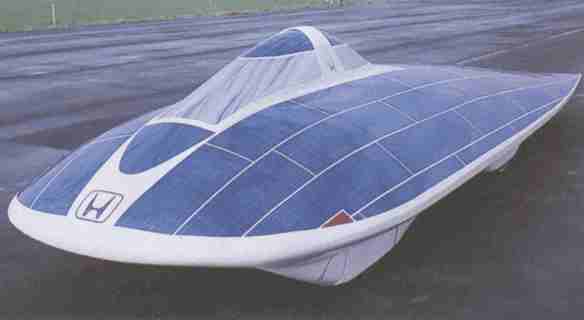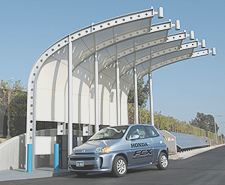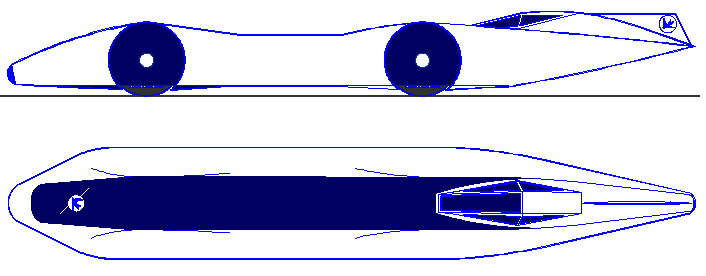|
One
time winner of the Darwin to Adelaide race and arguably, the most
expensive solar powered vehicle project to date. This Honda car was used
very successfully to advertise Honda road vehicles. This sums spent
developing this car would have built and equipped the Solar
Navigator trimaran.

Honda
- Darwin to Adelaide winner
Entrants
in the cross Australia race, from Darwin to Adelaide, use solar panels to
power a lightweight car over 2,000 miles at speeds of up to 50 miles per
hour. Clearly, solar power can deliver enough
energy to drive a vehicle considerable distance given the right
conditions.
Honda
Entering Solar Cell Market for Homes and Vehicles
- 18 December 2005
Nikkei.
Honda Motor is entering the market for solar cells designed for use in
households and also plans to promote their use in vehicles, according to a
report in the Nihon Keizai Shimbun.
Honda
is building a ¥10-billion (US$86.5-million) factory to begin mass
production in fiscal 2007 of solar cells made an inexpensive thin-membrane
non-silicon metal compound developed by Honda engineering. The Honda solar
panels, first announced in 2002, feature a light-absorbing layer formed by
a compound made of copper, indium, gallium and diselenium (CIGS).

Thin-film
solar cells based on CIGS (Cu(In,Ga)Se2) absorbers are among
the leading devices which are expected to lower the costs for photovoltaic
energy conversion. Other companies working with CIGS cells include Shell
Solar and Würth.
Early
Honda CIGS module prototypes had a maximum output of 112 W at dimensions
of 1,367 × 802 × 46 mm. Honda is working to improve the efficiency.
Honda’s
solar cells will likely sell for some 1.5 million yen each, 20%-30% less
than silicon-made cells, according to the report.
The
new plant will initially have an annual capacity to produce about 30
megawatts worth of solar cells, enough for 10,000 households a year.
Initially, the company aims to market them only in Japan. But it will
later sell them in overseas markets, eyeing mainly North America and
Europe, where demand is expected to surge in the future.
Honda
is also considering a scheme that would use solar cells to power a home
electrolysis unit for the production of hydrogen for vehicle refueling.
Honda’s current prototype home hydrogen
energy
systems rely on natural gas reforming.

Honda
combined its CIGS solar cells with a Honda-developed compact electrolysis
unit that uses a new Ruthenium-based catalyst in a prototype at its
Torrance, California facility.
The
prototype solar-powered electrolysis unit produces hydrogen at a rate of 2
normal cubic meters per hour (Nm3/hr).
HISTORY
The
Honda story is the story of one man, Soichiro Honda, and his unparalleled
achievement of bringing motor cycles to the masses. Soichiro Honda was a
mechanic, a racer, a businessman, and a manufacturer. But most of
all he was a dreamer. He dreamed of a better way of making piston rings,
founded a small company, and began production. He dreamed of giving people
everywhere an economical form of transportation, and began producing small
motorcycles, including one built in 1949 called the D-Type Dream.
He
also loved racing too. So his company built bigger and faster machines,
two, four, five and six-cylinder race bikes and won the Isle of Man.
Honda Motor Company is by far the world's
biggest motorcycle maker. Honda's first motorcycle was born out of
necessity in immediate post World War II Japan, where public
transportation was desperately overcrowded and gasoline severely
restricted.
Looking
for a solution to his, and thousands of others', personal transport
problems, Honda came across a job lot of 500 war surplus two-stroke motors
designed to power electric generators; nobody else wanted them so Honda
picked them up cheap. His aim
was to adapt them for attachment to push-bikes and, by October 1946, his
small factory in Hamamatsu was making complete, makeshift motor bikes
using proprietary cycle frames. Because gasoline was in short supply,
Honda adapted his motors to run on turpentine, a fuel that he himself
distilled from pine trees and sold throughout Japan. Turpentine (or gas
thinned out with turpentine) was not the best thing for powering
motorbikes, and required a lot of strenuous pedaling to warm the engine up
enough before you could get going.
Honda's
first bikes were very successful and supplies of the surplus engines ran
out after a few months. Business was good by then, so he decided to
manufacture his own motors. Using the surplus motor as a model, Honda
designed and built his own 50cc engine.
In
November 1947, the 1/2 horsepower A-Type Honda was being manufactured and
sold as a complete motorbike. Because the motorbike gave off a lot of
smoke and a stench of turpentine it was known as the "Chimney".
Soichiro Honda started Honda Motor Company in 1948, at the age of 41. Soon
after he hooked up with financial whiz Takeo Fujisawa and together they
built an empire.
1948
saw Honda introduce a 90cc version of the A-Type known as the
"B-Type". By 1949 Honda came out with the
"D-Type". Mr. Honda was involved in every step of the two-stroke
D-Type Dream's design and manufacture. This was Honda's first motorcycle.
This was far from simply slotting a motor into a pushbike frame. Honda
called his machine 'The Dream', because his dream of building a complete,
motorcycle had come true. Soichiro Honda was an engineer and was always
looking to produce better and more sophisticated machines.
It
turned out to be the 146cc, OHV, four-stroke E-Type Dream. A powerful
machine producing 5 1/2bhp capable of 50mph. It had a steel frame and
proper suspension front and rear. By October 1951 the new Dream was in
production at the rate of 130 units per day.
In
1952 Honda produced the first "Cub" F-Type, a 1/2 horsepower,
50cc, two-stroke engine that was produced in huge numbers. You could get
one to fit to your pushbike or buy the complete red and white Honda
"Auto Bai". Less than a year after its Introduction, production
was 6500 units per month, at that time it was 70% of Japan's powered
two-wheeler market.
In
1953 Honda produced the 90cc, four-stroke single, a motorcycle of even
greater sophistication. This was known as the Benly, in Japanese this
means "convenience". The J-Type Benly had a three-speed gearbox,
produced 3.8bhp, a pressed steel Frame, rear suspension with the engine
and swinging arm on a sprung pivot, and telescopic front suspension.
Before long they were selling at a rate of 1000 units a month.
In
1954 a 200cc scooter, the Juno, was introduced to capture some of the
sales from the Vespa scooter copies that were being built in Japan. Honda
produced different versions of the Dream and Benly motorcycles over the
next few years incorporating different size engines (up to 350cc) and
other refinements.
In
September 1957 Honda introduced their first twin-cylinder motorcycle, the
sophisticated 250cc OHC four-stroke C70 Dream. It was the forerunner of
Honda's high-performance 125 and 250cc twins. In early 1958
Honda fitted an electric starter to the 250cc Dream and named it the C71
and, in 1959, the latest Benly an incredibly sophisticated 125cc OHC
four-stroke twin, capable of 70mph was introduced as the C92.
In
July 1958 Honda introduced in Japan what became the world's most
successful motor cycle, the C100 Super Cub. The Super Cub was
developed over three years to be a cheap and practical motorcycle that
literally anyone could use. It used a 50cc four-stroke OHV motor and
centrifugal clutch with three-speed transmission. It was so easy to
operate that even new riders could ride it as easily as a pushbike. Its
innovative frame without a crossbar made it popular with the ladies and
set a new trend in commuter motorcycling. The word "scooterette"
was coined to describe this step-through style motorbike which sold in 50,
70 and 90cc versions.
In
1959 it was the first Honda motorcycle sold in the U.S., eventually
becoming the world's best-selling vehicle (30 million to date). As proof
the original concept and design was perfect is the fact that today's C50,
C70 and C90s have only detail changes to set them apart from the machines
of 25 years ago. That same year, 1959, Honda introduced the 250cc
C72 Dream in Amsterdam. This was the first Japanese bike to be officially
shown in Europe. It surprised the crowd with its unusual pressed steel
frame, swing arm and front leading link forks, sophisticated OHC all
aluminum engine, electric starter and indicators.
In
the UK learners had just been restricted to motorcycles of this size and
wanted the fastest bikes they could legally ride. The Honda's were the
fastest 250s around, and the C72 with its improvements like 12-volt
electric's and wet sump lubrication, successor of the C71, was capable of
80mph and could still get 66 miles per gallon. The CB92 retained the
pressed-steel frame and leading link forks while the CB72 received a
tubular style frame and telescopic front suspension.
In
1961 two years after Honda started selling Super Cubs, Honda stunned the
racing world with "Mike the Bike" Hailwood's twin victories at
the Isle of Man. It was the first of an unprecedented string of victories
that was only the beginning of Honda's racing tradition.
From
the beginning, Mr. Honda dedicated his company to racing, racking up over
100 major motorcycle championships around the world. What was learned from
building high-performance racing machines later led to the development of
groundbreaking production motorcycles.
The
classic CB72 and CB77 helped fuel interest in riding, got America on two
wheels, and established Honda as a serious player. The Hawk name has
appeared on Honda models CB72, CB77, CB400T, NT650, VTR1000F ever since,
the latest being the 1998 VTR1000F. In 1962 this breakthrough
advertising "You meet the nicest people on a Honda" shattered
the myth that motorcycles were only for tough guys and rebels. It reached
out and made Honda and motorcycling in general, appealing to everyone.
The
C77 a 305cc version of the Dream and the CB77, a Super Sports motorcycle
producing 28.5bhp were introduced in 1963. In 1964 the C95 a 154cc
version of the Benly and a 161cc version Of the CB160 was also offered.
The Hondells recorded "Little Honda" in 1964. Honda entered the
American pop culture as the subject of this hit song.
In
1965 Honda, always eager for a new market, jumped into the big leagues
with their first big, fast production motorcycle, the innovative 43bhp
CB450 twin. This was a double overhead-camshaft machine with torsion bar
valve springs that would do a genuine 104mph, a machine to challenge the
500cc-plus bikes. Despite its performance, sales of the CB450
worldwide were Poor. A number of engineering changes were made, in 1967 a
five-speed gearbox was added. In 1967 Honda had
their first big off-road win in the "first" Baja 1000.
In
1968 Honda stopped production of the CB72 and CB77 and produced a new line
of high performance SOHC twins with five-speed gearboxes, called the CB250
and CB350, with the CB350 able to hit 106mph.
At
the Tokyo Show of 1968 Honda, after months of tantalizing rumor, unveiled
a landmark achievement that would change the motorcycling world forever. A
750cc bike with four cylinders and a disc brake that was so fast and
powerful a new word, "superbike", was coined to describe it. The
CB750F four was the biggest bike out of Japan, proving that a
high-performance motorcycle could also be very reliable.
In
April 1969 Honda set the motorcycle world on fire with the introduction of
the CB750. Performance was staggering, easily hitting 120mph and at the
time it had better acceleration than anything else on the road.
In 1969 the first Honda automobile sold in the U.S., leading Honda to
become a preeminent automotive power.
Honda
EV test program
|
1947~59
|
|
'47
|
|
Honda’s
first product, the A-type bicycle engine, produced.
* A year
before the establishment of
Honda Motor Co., Ltd.
|
|
|
|
|
'49
|
|
Production
of the Dream D (2-stroke, 98cc), Honda’s first
production motorcycle, begins.
|
|
|
|
|
'51
|
|
Dream
E (4-stroke, 146cc) released.
|
|
|
|
|
'52
|
|
Cub
F (2-stroke, 50cc) released.
|
|
|
|
|
'53
|
|
Benly
J (4-stroke, 90cc) released.
|
|
|
|
|
'58
|
|
Long-selling
Super Cub C100 motorcycle released.
|
|
|
|
|
1960~69
|
|
'61
|
|
Knockdown
exports from Suzuka to Taiwan begin.
|
|
|
|
|
'63
|
|
Super
Cub awarded the French Mode Cup.
|
|
|
|
|
'68
|
|
Motorcycle
production reaches 10 million units.
|
|
|
|
|
'69
|
|
Dream
CB750 Four, with a 4-cylinder engine, released; export
of the bike to North America begins.
|
|
|
|
|
1970~79
|
|
'72
|
|
Elsinore
CR250M released.
|
|
|
|
|
'74
|
|
Gold
Wing GL1000 released in US.
|
|
|
|
|
|
|
1980~89
|
|
'80
|
|
Tact
scooter released.
|
|
|
|
|
'82
|
|
VF750
Magna released.
|
|
|
|
|
'87
|
|
Tact
Fullmark released.
Japanese motorcycle production reaches
50 million units.
|
|
|
|
|
'88
|
|
US-made
Gold Wing Touring motorcycle released in Japan.
Thai-made Cub 100EX released in Japan.
|
|
|
|
|
1990~99
|
|
'90
|
|
Super
Cub receives Japan Design Award.
|
|
|
|
|
|
'92
|
|
Super
Cub production reaches 20 million units.
|
|
|
|
|
'94
|
|
Limited-edition
sales of CUV-ES electric scooter begin.
|
|
|
|
|
'96
|
|
Sales
of Valkyrie, a large US-made custom motorcycle, begin.
|
|
|
|
|
'97
|
|
Motorcycle
production reaches 100 million units.
|
|
|
|
|
'99
|
|
Giorno
Crea, a water-cooled 4-stroke 50cc scooter, released.
|
|
|
|
|
2000~03
|
|
'00
|
|
Environment-friendly
VFR sports motorcycle released.
|
|
|
|
'01
|
|
400cc
scooter, Silver Wing, released. Dio, a 50cc water-cooled
4-stroke scooter, released.
US-made 1800cc Gold Wing sports touring model released.
|
|
|
|
|
|
'02
|
|
Chinese-made
scooter, Today, released.
100cc Ape with a 5-speed transmission released.
Super Cub sales reach 35 million units.
|
|
|
|
'03
|
|
Pantheon,
first motorcycle equipped with a small PGM-FI, released
in Europe.
CBR600RR SuperSports bike released.
|
|
Any
form of electric vehicle is better than petrol or diesel, but an
electric vehicle that can refuel in a few minutes will obviously have
much more customer appeal than an EV that has to wait 30 minutes or
even hours to charge up.
Battery
technology is improving daily. A car with the new generation of
battery cartridge exchange built in and the ability to load its own
cartridge, will encourage energy companies to build service
forecourts.
The
Blueplanet Ecostar (BE3) LSR Team would be pleased to advise any
energy company interested in this technology and of course any vehicle
manufacturer who might be considering whether or not to include a
future proof system into their next generation of road cars.
Please
click on the links above to find out about these famous automotive
makers. If your company is not included and you would like to
be listed, please let us know.
UK
VEHICLE INSURANCE ONLINE A - Z
No
matter what car, van or bike you drive, we're all looking for great
value and quality in our UK motor insurance? But who is the
best - who is the cheapest and who offers the great service in the
event of a claim?
See
the insurance companies below who claim to offer competitive cover
at sensible prices, our
guide to the jargon and tips for cutting your quote - Good
Luck:-
CONTACTS
A
taste for adventure
capitalists

The
world's fastest electric car: 350mph + using energy from nature.
Featuring built in battery cartridge exchange, charged using
renewable solar energy. Sponsors sought for the 2016 season.
|
![]() and
name Bluebird
and Blue Max are trademarks. The BE2 and BE3 vehicle shape and
configuration are registered designs ®. All other trademarks
are hereby acknowledged. Max Energy Limited is an educational
charity.
and
name Bluebird
and Blue Max are trademarks. The BE2 and BE3 vehicle shape and
configuration are registered designs ®. All other trademarks
are hereby acknowledged. Max Energy Limited is an educational
charity.


